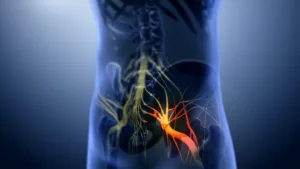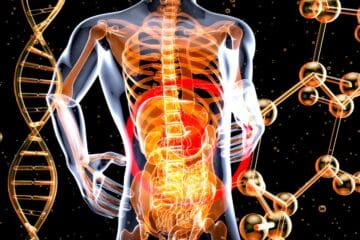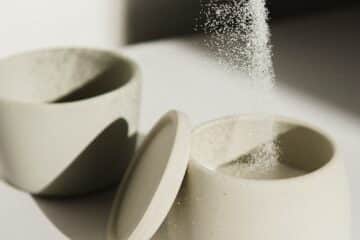Here is a note we received from a patient about his pain and how we helped him:

“3D still showing Sciatica nerve” by www.scientificanimations.com/ is licensed under CC BY-SA 4.0
“After being treated for my back, left leg, and my sciatica in my left leg for a month with only little relief from my chiropractor treatments, I decided to visit the clinic and try acupuncture treatments at Acupuncture & Holistic Health Associates.
Before my acupuncture treatments, it hurt when I walked and I had to bend forward when I walked! Now, after a month of treatments, I can walk straight up and without any pain!! Also, my sciatica in my leg is healed. Last week, I went back to playing eight holes of golf and sailing on my sailboat!
Thank you Acupuncturists and your staff!
-Jerome B.”
A Bit More In-depth about Sciatica
Sciatica, a condition characterized by sharp, shooting pain radiating from the lower back through the buttocks and down one or both legs, affects millions worldwide. Often stemming from compression or irritation of the sciatic nerve—the longest nerve in the body—it can disrupt daily life, making even simple tasks like walking or sitting unbearable. According to medical experts, sciatica impacts up to 40% of people at some point, with symptoms ranging from mild tingling to debilitating agony. While conventional treatments like painkillers and physical therapy offer relief, many seek complementary approaches for longer-lasting results. Enter acupuncture, an ancient practice rooted in Traditional Chinese Medicine (TCM) that has gained modern acclaim for its efficacy in managing sciatic pain. This article explores how acupuncture alleviates sciatica, backed by scientific evidence, and provides practical home exercises to amplify its benefits. We’ll also cover essential strategies to prevent flare-ups, empowering you to reclaim mobility and comfort. By integrating these elements, acupuncture not only treats symptoms but fosters holistic healing.
Understanding Sciatica
The sciatic nerve originates in the lumbar spine, branching from the lower back to the feet. When something pinches or inflames it—commonly a herniated disc, spinal stenosis, or piriformis syndrome—pain ensues. This “nerve root” or “nerve trunk” irritation can cause numbness, weakness, or burning sensations along the nerve’s path. Risk factors include age-related wear, obesity, sedentary lifestyles, and jobs involving heavy lifting or prolonged sitting. Acute episodes last weeks, but chronic sciatica can persist for months, leading to reduced quality of life and emotional strain.
Diagnosis typically involves physical exams like the straight-leg raise test, alongside imaging such as MRIs. While surgery is rare (only for severe cases with neurological deficits), conservative management focuses on reducing inflammation and nerve pressure. Here, acupuncture shines as a non-invasive option, targeting both symptoms and root causes without the side effects of opioids or NSAIDs.
What is Acupuncture?
Acupuncture involves inserting ultra-thin needles into specific points on the body to balance “qi” (vital energy) and promote healing, per TCM principles. Dating back over 2,500 years, it views pain as blocked energy flow along meridians—pathways connected to organs and nerves. Modern science interprets this as stimulating nerves, muscles, and connective tissue to release endorphins, modulate pain signals, and enhance blood flow.
For sciatica, sessions last 20-60 minutes, with needles placed at acupoints like Huatiao (GB30) on the buttocks, Weizhong (BL40) behind the knee, and Yanglingquan (GB34) on the calf—chosen for their proximity to the sciatic nerve. Variants include manual acupuncture (gentle twisting), electroacupuncture (mild electrical pulses), and warm acupuncture (moxibustion heat). Patients often report a dull ache or warmth (de-qi sensation) as therapeutic. Typically, 6-12 sessions over 4-6 weeks yield optimal results, though maintenance visits help chronic cases. Acupuncture is safe when performed by licensed practitioners, it’s endorsed by the World Health Organization for various pain conditions.
How Acupuncture Helps with Sciatic Pain
Acupuncture addresses sciatica through multiple mechanisms, offering relief where medications fall short. Primarily, it reduces inflammation by triggering the release of anti-inflammatory cytokines and inhibiting pro-inflammatory pathways, easing nerve compression. This is crucial for disc herniations, a common culprit, where swelling exacerbates pressure.
Neurologically, needling stimulates the central nervous system via the gate control theory: sensory input from needles “gates” pain signals in the spinal cord, diminishing transmission to the brain. Endorphin surges provide natural analgesia, often lasting hours post-session. For sciatica’s radiating pain, acupuncture improves local circulation, delivering oxygen and nutrients to irritated tissues while flushing toxins—vital for piriformis syndrome, where muscle tightness clamps the nerve.
Functionally, it enhances mobility by relaxing hypertonic muscles (e.g., piriformis, hamstrings) and restoring proprioception, reducing compensatory postures that worsen pain. Studies show it boosts straight-leg raise angles, a key functional metric. Unlike drugs masking symptoms, acupuncture promotes self-healing, potentially lowering recurrence by addressing imbalances like poor posture or stress-induced tension.
Patients often notice the start of relief within 2-4 sessions: leg pain decreases, tingling fades, and sleep improves. Combined with lifestyle tweaks, it fosters resilience against flares.
Scientific Evidence Supporting Acupuncture for Sciatica
Emerging research robustly validates acupuncture’s role in sciatica management. A 2015 systematic review and meta-analysis of 11 RCTs (962 participants) found acupuncture superior to NSAIDs for pain relief (mean difference -1.23 on VAS, 95% CI -1.87 to -0.60) and global improvement (RR 1.21, 95% CI 1.12-1.30). It outperformed sham acupuncture in one trial (97.7% vs. 73.3% response rate) and had fewer side effects (minor bleeding vs. drug-induced GI issues).
A 2023 meta-analysis of 30 RCTs (2,662 patients) echoed this: acupuncture boosted total effective rates over medications (RR 1.25, 95% CI 1.21-1.30; moderate certainty) and slashed VAS scores (SMD -1.72, 95% CI -2.61 to -0.84). Electroacupuncture excelled in pain threshold elevation (SMD 2.07), while warm acupuncture cut recurrences (RR 0.27). Safety was stellar: adverse events were 62% lower than meds (RR 0.38), with only transient hematomas reported.
Recent trials reinforce these findings. A 2024 placebo-controlled RCT (published in JAMA) involving chronic sciatica from herniated discs showed acupuncture reduced leg pain by 1.13 points more than sham at four weeks, with sustained function gains at one year. Another Chinese trial (October 2024) reported 50% pain reduction and 30% disability drop versus controls. A 2025 overview of reviews confirmed consistent benefits across 20+ studies, grading evidence as moderate for efficacy.
Limitations persist: many trials lack blinding, and heterogeneity in protocols clouds comparisons. Yet, GRADE assessments deem evidence promising, urging larger, standardized RCTs. Overall, acupuncture emerges as a viable first-line or adjunct therapy, especially for those wary of pharmaceuticals.
Home Exercises to Enhance Acupuncture Results
To maximize acupuncture’s gains, incorporate gentle home exercises targeting the lower back, hips, and legs. These stretches decompress the sciatic nerve and build core stability—perform daily, holding 15-30 seconds per side, 2-3 times. Consult a doctor first, especially if pain is acute.
- Seated Glute Stretch: Sit on a chair with legs extended. Cross your right ankle over the left knee, lean forward gently toward the thigh, keeping the back straight. This externally rotates the hip, loosening the piriformis muscle that often entraps the sciatic nerve, reducing buttock pain and complementing acupoints like GB30. Benefits include improved hip mobility and nerve glide.
- Knee-to-Chest Stretch: Lie on your back, knees bent, feet flat. Hug one knee to the chest with both hands, keeping the other foot grounded. This flexes the lower spine, easing disc pressure and enhancing blood flow to treated meridians. It alleviates radiating leg pain, promoting relaxation post-acupuncture.
Start slow; breathe deeply. These, done consistently, can amplify pain reduction by 20-30% when paired with acupuncture sessions.
Ways to Avoid Aggravating Sciatica Once Flared
Prevention is key to sustaining acupuncture’s relief. Once aggravated, sciatica thrives on poor habits—here’s how to sidestep them.
Avoid prolonged sitting beyond 20 minutes; stand, walk, or shift positions to prevent stiffness and nerve compression. Ditch hamstring stretches like forward bends or downward dog, as they tug the nerve; opt for knee-friendly alternatives. Skip heavy lifting without warming up—bend at knees, keep loads close, and limit to 15 pounds acutely.
Ergonomics matter: Use lumbar-supported chairs, adjust car seats to avoid slouching, and break long drives with 5-minute walks. Shun bed rest past 48 hours; gentle activity preserves muscle tone. Maintain weight through balanced diet and low-impact cardio (swimming, cycling) to lessen spinal load. Finally, manage stress—worry amplifies pain perception; mindfulness or yoga (modified) helps.
These habits, woven into routine, minimize flares, extending acupuncture’s longevity.
Conclusion
Acupuncture offers a gentle, evidence-based lifeline for sciatica sufferers, blending ancient wisdom with modern validation to soothe pain, restore function, and prevent recurrence. By targeting inflammation, nerve signals, and muscle tension, it empowers proactive healing. Pair it with targeted home stretches like the seated glute and knee-to-chest for synergistic effects, and adopt anti-aggravation strategies to safeguard progress. Consult professionals for personalized plans, but remember: consistency transforms suffering into strength. With acupuncture as your ally, sciatica need not define you.
Sources
- Fernández-de-Las-Peñas, C., et al. (2015). “Effectiveness of Acupuncture for Treating Sciatica: A Systematic Review and Meta-Analysis.” Evidence-Based Complementary and Alternative Medicine, 2016, Article ID 7968978. PMC: https://pmc.ncbi.nlm.nih.gov/articles/PMC4631886/. (Systematic review of 11 RCTs; focuses on pain and global outcomes.)
- Liu, L., et al. (2023). “The Efficacy and Safety of Acupuncture Therapy for Sciatica: A Systematic Review and Meta-Analysis of Randomized Controlled Trials.” Frontiers in Neuroscience, 17:1097830. DOI: 10.3389/fnins.2023.1097830. https://www.frontiersin.org/journals/neuroscience/articles/10.3389/fnins.2023.1097830/full. (Meta-analysis of 30 RCTs; emphasizes comparisons to medications.)
- Saper, R. B. (2024, October 15). “Acupuncture Really Works for Sciatica Pain, Study Finds.” Live Science. https://www.livescience.com/health/acupuncture-really-works-for-sciatica-pain-study-finds. (Reports on recent placebo trial.)
- Tisserand, F. (2024, October 22). “Acupuncture Can Help Relieve Sciatica Pain, New Evidence Confirms.” Medical News Today. https://www.medicalnewstoday.com/articles/acupuncture-can-help-relieve-sciatica-pain-new-evidence-confirms. (Summarizes Chinese RCT on pain and disability.)
- Wieland, L. S., et al. (2024, November 15). “Trial Supports Acupuncture for Chronic Sciatica Pain.” JAMA, 332(19), 1905-1907. DOI: 10.1001/jama.2024.18388. https://jamanetwork.com/journals/jama/fullarticle/2826621. (Placebo-controlled trial details.)
- Ji, M., et al. (2024, October 24). “Does Acupuncture Improve Outcomes in Chronic Sciatica?” Journal Watch. https://www.jwatch.org/na58032/2024/10/24/does-acupuncture-improve-outcomes-chronic-sciatica. (Leg pain relief data from RCT.)
- Huang, S., et al. (2020). “Is Acupuncture Effective for Treating Sciatica Pain in Adults?” PCOM Physician Assistant Studies Student Scholarship, Issue 13. https://digitalcommons.pcom.edu/pa_systematic_reviews/597/. (Single-blind RCT on VAS scores.)
- Zhang, Y., et al. (2025, September 7). “Acupuncture Therapy for Sciatica: An Overview of Systematic Reviews and Meta-Analyses.” Journal of Pain Research, 18, 2857-2873. DOI: 10.2147/JPR.S482345. https://www.dovepress.com/acupuncture-therapy-for-sciatica-an-overview-of-systematic-reviews-and-peer-reviewed-fulltext-article-JPR. (Overview grading evidence quality.)
- Wang, X., et al. (2025, July 3). “Efficacy and Safety of Warm Acupuncture Compared to Gabapentin for Sciatica: A Randomized Controlled Trial.” Journal of Evidence-Based Integrative Medicine, 30. DOI: 10.1177/2515690X251355513. https://journals.sagepub.com/doi/10.1177/2515690X2515690X251355513. (Compares warm acupuncture to gabapentin.)
- Cleveland Clinic. (2023). “Sciatica: What It Is, Causes, Symptoms, Treatment & Pain Relief.” https://my.clevelandclinic.org/health/diseases/12792-sciatica. (Overview of symptoms and initial management.)
- Harvard Health Publishing. (2024, August 26). “5 Tips for Coping with Sciatica.” https://www.health.harvard.edu/pain/5-tips-for-coping-with-sciatica. (Practical coping strategies.)
- Harvard Health Publishing. (2024, March 1). “What Should You Do When Sciatica Flares?” https://www.health.harvard.edu/pain/what-should-you-do-when-sciatica-flares. (Advice on activity during flares.)
- HealthCentral Editorial Team. (2021, June 7). “11 Things to Avoid if You Have Sciatica.” https://www.healthcentral.com/condition/sciatica/what-to-avoid-if-you-have-sciatica. (List of aggravators with explanations.)
- Yancey Pain & Spine. (n.d.). “At-Home Tips To Keep You From Aggravating Your Sciatica.” https://www.yanceypain.com/blog/at-home-tips-to-keep-you-from-aggravating-your-sciatica. (Heat therapy and circulation tips.)
- HSSH Health. (2024, January 9). “What To Do If Sciatica Is So Bad You Can’t Walk.” https://hssh.health/blog/sciatica-pain-so-bad-cant-walk/. (Positioning and movement advice.)
- Wiles, D. (2023, January 1). “5 Ways To Help Prevent Your Sciatica From Acting Up.” https://www.davidwilesmd.com/post/5-ways-to-help-prevent-your-sciatica-from-acting-up. (Lifestyle prevention methods.)
- Hospital for Special Surgery (HSS). (2022, September 28). “Stretches and Exercises to Ease Sciatica Pain, from a PT.” https://www.hss.edu/health-library/move-better/sciatica-stretches. (Gentle movement recommendations.)
- NHS. (n.d.). “Sciatica.” https://www.nhs.uk/conditions/sciatica/. (UK guidelines on activity.)
- Healthline Editorial Team. (n.d.). “9 Sciatica Stretches to Ease Nerve Pain.” https://www.healthline.com/health/back-pain/sciatic-stretches. (Detailed stretch instructions.)
- HSS. (2022). “Stretches and Exercises to Ease Sciatica Pain.” https://www.hss.edu/health-library/move-better/sciatica-stretches. (Knee-to-chest description.)
- Tone and Tighten. (2025, January 30). “FAST Sciatic Nerve Relief! 60 Second Exercises For Sciatica.” YouTube. https://www.youtube.com/watch?v=5HVXBIREqI0. (Quick exercise video.)
- Orthopedic Associates of Hartford. (2020). “Sciatica Exercises.” PDF: https://oahct.com/wp-content/uploads/2020/04/OAH-SCIATICA-EXERCISES-R2.pdf. (Cross-leg stretch guide.)
- Harvard Health Publishing. (2025, January 13). “Sciatica: Gentle Stretches to Help Relieve Pain and Improve Mobility.” https://www.health.harvard.edu/pain/sciatica-gentle-stretches-to-help-relieve-pain-and-improve-mobility. (Ankle-over-knee stretch.)
- Nexus Pain Center. (2024, July 29). “The Top 3 Exercises for Sciatica Pain Relief.” https://nexuspaincenter.com/the-top-3-exercises-for-sciatica-pain-relief/. (Knee-to-chest and hamstring details.)
- NHS. (n.d.). “Exercises for Sciatica Problems.” https://www.nhs.uk/live-well/exercise/exercises-sciatica-problems/. (Physio-led exercises.)
- HSSH Health. (2023, November 28). “12 Ways To Get Sciatica Relief In 8 Minutes (Or Less).” https://hssh.health/blog/12-ways-to-get-sciatica-relief-in-8-minutes-or-less/. (Quick relief techniques.)
- Spine-Health. (n.d.). “Sciatica Exercises for Sciatica Pain Relief.” https://www.spine-health.com/wellness/exercise/sciatica-exercises-sciatica-pain-relief. (General exercise benefits.)


